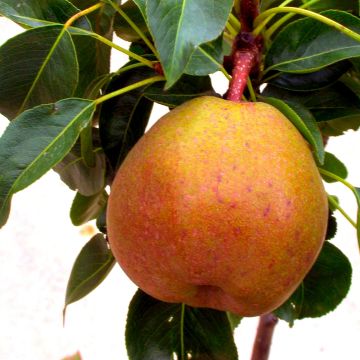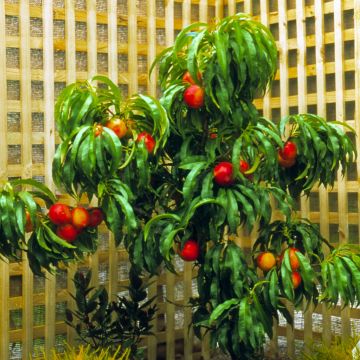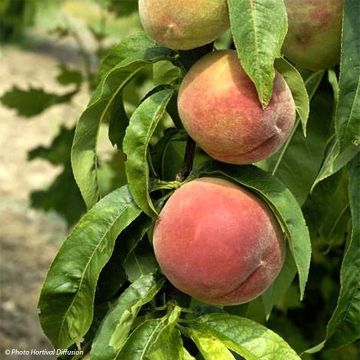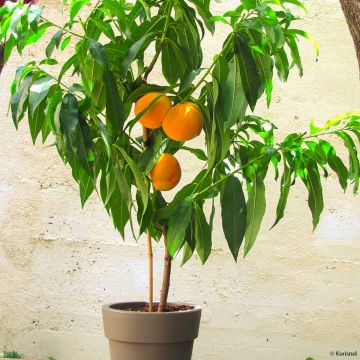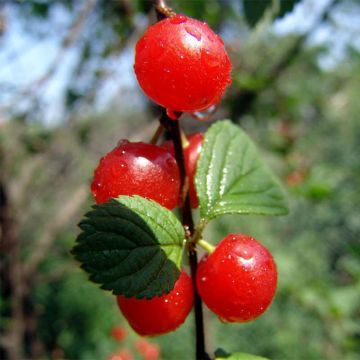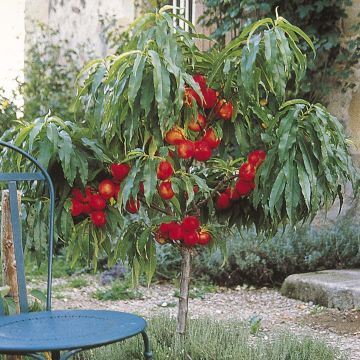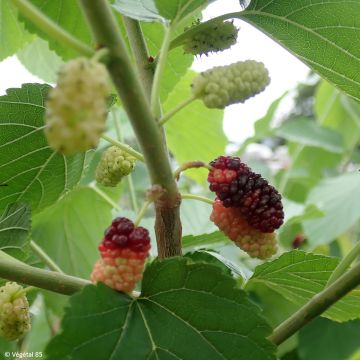

Pyrus communis Luisa - Common Pear
Pyrus communis Luisa - Common Pear
Pyrus communis Louisa (Luisa)
Common Pear
This item cannot be shipped to the selected country
Delivery charge from €5.90
More information
Schedule delivery date,
and select date in basket
This plant carries a 6 months recovery warranty
More information
We guarantee the quality of our plants for a full growing cycle, and will replace at our expense any plant that fails to recover under normal climatic and planting conditions.
From €5.90 for pickup delivery and €6.90 for home delivery
Express home delivery from €8.90.
Description
The Dwarf Pear Tree 'Luisa' is a slow-growing fruit tree with moderate development, reaching a height of less than 2m (7ft), making it ideal for container gardening. Being self-fertile, it does not require another tree nearby to bear fruit. After a beautiful white spring flowering, it produces an abundant harvest of round and sweet pears in September. This plant is very hardy and requires little maintenance as long as it is exposed to sunlight and receives regular watering.
Pear Trees, or Pyrus communis, belongs to the large family of Rosaceae, which includes many ornamental genera (Rose, Amelanchier, Japanese Quince...) as well as most of our temperate climate fruit trees (Cherry, Apple, Apricot, Peach...). Originally from central Asia and cultivated in China for 6,000 years, Pear Trees were introduced to Europe around the 6th century. Over the years, breeders have worked to introduce new compact varieties to the market by combining them with dwarfing rootstocks, allowing the cultivation of dwarf fruit trees for enthusiasts without large gardens. The aim is to enable them to plant these trees at home or even cultivate them in pots on a terrace or balcony.
The Dwarf Pear Tree 'Luisa' is one of these successes, as it generally reaches a height of 1.80m (6ft) and a width of approximately 1m (3ft) after 10 years of growth. It is a true miniature tree with a relatively upright habit, forming a few well-branched brown-grey-trunked scaffolds that branch out laterally to form a beautiful tuft. Its foliage consists of dark green oval leaves, finely toothed at the leaf margin and carried on a long flexible petiole. In March, the typical white flowering of the species appears, which undoubtedly adds charm and beauty to your living space in spring. 'Luisa' is a self-fertile variety, so these flowers will be pollinated without the need for another Pear Tree nearby, which is a great advantage for container gardening.
The fruits that form then ripen in September and are round in shape, measuring about 7cm (3in) in diameter. They have a green colour with subtle brown speckles and a very sweet taste. A well-developed tree can produce between 30 to 40 fruits, which have a relatively short shelf life and should therefore be consumed fairly quickly. If the clusters are too heavy, it is advisable to remove some young fruits before they grow larger to allow the others to reach a sufficient size.
This small tree can withstand temperatures as low as approximately -20°C (-4°F), but it should be protected from cold winter winds. It is also important to remember that a potted plant is more susceptible to temperature changes compared to one planted in the ground, as the roots do not benefit from the thermal inertia of the soil... Pear trees thrive in full sun but does not tolerate drought, so it is necessary to keep the substrate moist in the pot to ensure a good harvest.
Dwarf fruit trees allow you to enjoy the pleasures of gardening even on a simple terrace or balcony. Many species are now available, such as Cherry Trees, like the variety 'Sylvia', which is also self-fertile and grows as a column reaching 1.50m (5ft) in height and only 50cm (20in) in width, producing sweet and crunchy fruits. Among the Apple Trees, 'Croquella' is a good choice with its stunning red fruits that have a crunchy, juicy, and fragrant flesh. For a more southern touch, the Dwarf Peach Tree 'Ice Peach' will surprise you with its aesthetically pleasing fruits with white skin and white, deliciously sweet, and fragrant flesh. And for even more exoticism, adopt a citrus tree like the Kumquat, easily recognizable by its elongated orange fruits, which will need protection during cold climates in winter.
Report an error about the product description
Plant habit
Fruit
Flowering
Foliage
Botanical data
Pyrus
communis
Louisa (Luisa)
Rosaceae
Common Pear
Cultivar or hybrid
Other Pear trees
Planting and care
Plant the dwarf Pear tree 'Luisa' in a sunny location, in acidic or neutral soil, even slightly chalky, cool, but without excess, or in a pot at least 40cm (16in) in diameter and 50cm (20in) deep.
In open ground, dig a planting hole twice as wide and deep as the pot. Before planting, place the tree with its pot in a basin of water, so as to moisten the entire root ball by capillarity. In slightly heavy soil, ensure drainage by placing a thin layer of gravel at the bottom of the hole, add compost and install the tree in the hole, fill with soil mixed with compost. Do not bury the graft collar and position the root ball so that the top is level with the surface of the soil. Water abundantly to compact the soil around the root ball.
In a pot, choose a container that is large enough and if it is not already, pierce it, install a layer of clay pellets or gravel at the bottom for drainage. Fill with a mixture of potting soil and garden soil, make sure to leave the graft collar above the soil, firm it slightly and water copiously. Monitor the watering of your fruit tree in a pot and apply fertilizer once a year. Repotting takes place in early spring, it is essential, but can be done every two years if the container is large enough.
Planting period
Intended location
Care
This item has not been reviewed yet - be the first to leave a review about it.
Fruit trees for small gardens
Haven't found what you were looking for?
Hardiness is the lowest winter temperature a plant can endure without suffering serious damage or even dying. However, hardiness is affected by location (a sheltered area, such as a patio), protection (winter cover) and soil type (hardiness is improved by well-drained soil).

Photo Sharing Terms & Conditions
In order to encourage gardeners to interact and share their experiences, Promesse de fleurs offers various media enabling content to be uploaded onto its Site - in particular via the ‘Photo sharing’ module.
The User agrees to refrain from:
- Posting any content that is illegal, prejudicial, insulting, racist, inciteful to hatred, revisionist, contrary to public decency, that infringes on privacy or on the privacy rights of third parties, in particular the publicity rights of persons and goods, intellectual property rights, or the right to privacy.
- Submitting content on behalf of a third party;
- Impersonate the identity of a third party and/or publish any personal information about a third party;
In general, the User undertakes to refrain from any unethical behaviour.
All Content (in particular text, comments, files, images, photos, videos, creative works, etc.), which may be subject to property or intellectual property rights, image or other private rights, shall remain the property of the User, subject to the limited rights granted by the terms of the licence granted by Promesse de fleurs as stated below. Users are at liberty to publish or not to publish such Content on the Site, notably via the ‘Photo Sharing’ facility, and accept that this Content shall be made public and freely accessible, notably on the Internet.
Users further acknowledge, undertake to have ,and guarantee that they hold all necessary rights and permissions to publish such material on the Site, in particular with regard to the legislation in force pertaining to any privacy, property, intellectual property, image, or contractual rights, or rights of any other nature. By publishing such Content on the Site, Users acknowledge accepting full liability as publishers of the Content within the meaning of the law, and grant Promesse de fleurs, free of charge, an inclusive, worldwide licence for the said Content for the entire duration of its publication, including all reproduction, representation, up/downloading, displaying, performing, transmission, and storage rights.
Users also grant permission for their name to be linked to the Content and accept that this link may not always be made available.
By engaging in posting material, Users consent to their Content becoming automatically accessible on the Internet, in particular on other sites and/or blogs and/or web pages of the Promesse de fleurs site, including in particular social pages and the Promesse de fleurs catalogue.
Users may secure the removal of entrusted content free of charge by issuing a simple request via our contact form.
The flowering period indicated on our website applies to countries and regions located in USDA zone 8 (France, the United Kingdom, Ireland, the Netherlands, etc.)
It will vary according to where you live:
- In zones 9 to 10 (Italy, Spain, Greece, etc.), flowering will occur about 2 to 4 weeks earlier.
- In zones 6 to 7 (Germany, Poland, Slovenia, and lower mountainous regions), flowering will be delayed by 2 to 3 weeks.
- In zone 5 (Central Europe, Scandinavia), blooming will be delayed by 3 to 5 weeks.
In temperate climates, pruning of spring-flowering shrubs (forsythia, spireas, etc.) should be done just after flowering.
Pruning of summer-flowering shrubs (Indian Lilac, Perovskia, etc.) can be done in winter or spring.
In cold regions as well as with frost-sensitive plants, avoid pruning too early when severe frosts may still occur.
The planting period indicated on our website applies to countries and regions located in USDA zone 8 (France, United Kingdom, Ireland, Netherlands).
It will vary according to where you live:
- In Mediterranean zones (Marseille, Madrid, Milan, etc.), autumn and winter are the best planting periods.
- In continental zones (Strasbourg, Munich, Vienna, etc.), delay planting by 2 to 3 weeks in spring and bring it forward by 2 to 4 weeks in autumn.
- In mountainous regions (the Alps, Pyrenees, Carpathians, etc.), it is best to plant in late spring (May-June) or late summer (August-September).
The harvesting period indicated on our website applies to countries and regions in USDA zone 8 (France, England, Ireland, the Netherlands).
In colder areas (Scandinavia, Poland, Austria...) fruit and vegetable harvests are likely to be delayed by 3-4 weeks.
In warmer areas (Italy, Spain, Greece, etc.), harvesting will probably take place earlier, depending on weather conditions.
The sowing periods indicated on our website apply to countries and regions within USDA Zone 8 (France, UK, Ireland, Netherlands).
In colder areas (Scandinavia, Poland, Austria...), delay any outdoor sowing by 3-4 weeks, or sow under glass.
In warmer climes (Italy, Spain, Greece, etc.), bring outdoor sowing forward by a few weeks.



































